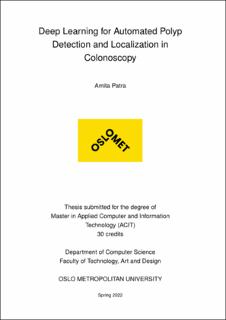Deep learning for automated polyp detection and localization in colonoscopy
Master thesis
Published version
Permanent lenke
https://hdl.handle.net/11250/3017373Utgivelsesdato
2022Metadata
Vis full innførselSamlinger
Sammendrag
Gastrointestinal (GI) tract comprises organs from mouth to anus. Multiple diseases can occur in the GI tract. Among the different diseases in the
digestive system, the most commonly found cancer in the gastrointestinal tract are oesophagus cancer, stomach cancer and colorectal cancer (CRC).
Amongst them, CRC is the third most commonly caused cancer in terms of incidence and the second most commonly leading cause of cancer-related
death worldwide. Norway specifically has the highest occurrence of colon cancer worldwide. Prior detection is a crucial factor to improve chances of survival, prognosis and timely treatment. Recently, there has been significant progress made in the field of medical image analysis through the development of Computer-aided diagnosis systems. CADx systems utilizing machine learning algorithms, specifically deep learning methods have produced excellent object detection models for automatic detection of abnormalities in medicine. In this respect, this thesis explores the possibility of implementing recent state-of-the-art deep learning models for automated polyp detection. The You Only Look Once (YOLO) family of models have demonstrated good results for object detection tasks, especially YOLOv4. Lately, YOLOv5, YOLO Representation (YOLOR) and Paddle- Paddle YOLO (PP-YOLO) were released which have shown even an improved performance over the earlier version YOLOv4. These real-time detection models were used together with the Kvasir-SEG dataset and BKAI-IGH NeoSmall-Polyp that contains several GI tract images with annotations to detect CRC precursor lesions called polyps. The models were compared to previous state-of-the-art models using metrics mAP, precision and recall. The models showed improved performance for mAP value. Additionally, we also achieved real-time processing speed with our models. However, the models achieved satisfactory accuracy for detection which indicates that there is still future scope for improvement. The experimental results presented in the
study show that the presented method can be a strong benchmark for the development of an automated polyp detection system in real-world clinical applications.
